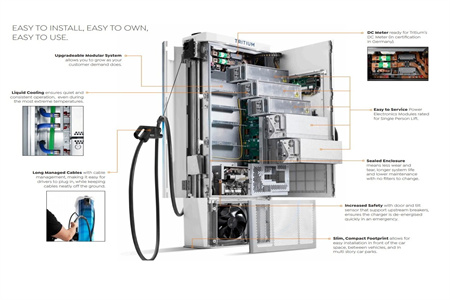On December 27,2019, Tesla’s first V3 supercharging pile in China was officially opened to the public. The V3 supercharging pile adopts full liquid cooling design, and the high power of 400V / 600A can increase the range of 250 kilometers in Model3 15 minutes. The arrival of V3 means that electric vehicles will once again break the limit in terms of energy supplement efficiency.
The buried all-liquid-cooled supercharging system is being deployed and installed, and it will be powered up at the supercharging site in Germany two months later. Different from Tesla V3 full liquid cooled charging pile, the buried charging pile supports a high power output of 1000V / 600A, and the maximum power is twice that of Tesla V3 supercharging pile.
On December 27,2019, Tesla’s first V3 supercharging pile in China was officially opened to the public. The V3 supercharging pile adopts full liquid cooling design, and the high power of 400V / 600A can increase the range of 250 kilometers in Model3 15 minutes. The arrival of V3 means that electric vehicles will once again break the limit in terms of energy supplement efficiency.
At the same time, the buried all-liquid cooling supercharging system is being deployed and installed, and it will be powered up at the supercharging site in Germany two months later. Different from Tesla V3 full liquid cooled charging pile, the buried charging pile supports a high power output of 1000V / 600A, and the maximum power is twice that of Tesla V3 supercharging pile.
V2G and full liquid-cold charging,
The liquid-cooled charging module is no different from the traditional air-cooled charging module in the electrical principle, but the key is the heat dissipation mode. Air cooling, as the name suggests, is done with a fan; but liquid cooling is different, considering the close contact between the coolant and the heating device and the conductivity without any contact with the electrical components; and the design from the liquid cooling module to the full liquid cooled charging pile requires high thermal design capability of the system development team. In the early stage, domestic module enterprises were not optimistic about liquid cooling modules, which were difficult to develop and invested many resources. Compared with traditional air-cooled modules, the cost of liquid cooling modules was too high. In the case of fierce competition in domestic module price, the development could be accepted by the market
MIDA sees the development trend of electric vehicle charging technology and the many advantages of full-liquid cold charging brought to users. Since the dule does not need a fan and relies on the coolant to dissipate heat, can the charging pile be designed into a closed iron box and then buried in the ground, only exposing the charging gun on the ground? This saves space, is environmentally friendly and very high. Unlike Tesla’s traditional split design for all-liquid-cooled supercharging piles, MIDA’s all-liquid-cooled supercharging pile adopted this imaginative design from the very beginning. The charging module adopts the blade design, which is easy to plug and unplug, while the charging pile is buried. The user only needs to insert the gun and scan the code to start the high-power overcharge. The heat dissipation of the system is also very delicate, the use of local cooling, or the use of fountains, water pipes and other external water to heat.
The buried system was originally aimed at overseas customers, and once it was launched in 2020, it was well received by customers. At present, the largest liquid cooling supercharging station in Europe is the batch deployment of the buried all liquid cooling supercharging pile, and the site has become a local web celebrity site.
Post time: Mar-12-2024






